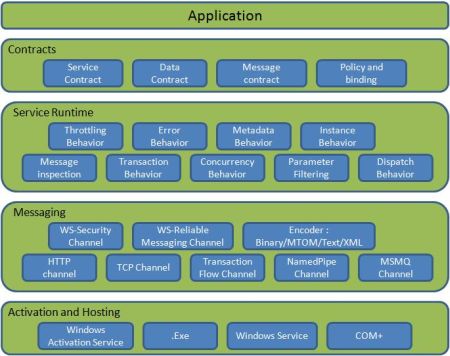|
|
|
|
|
Similar ArticlesMost ReadTop RatedLatest
|
|
|
|
|
|

|
|
|

|
|
|
|
|
|
|
|
|
|
|

|
|
|

|
|
The Windows Communication Foundation (WCF) Architecture is divided into five
different layers which are described as below:

Figure 1: WCF Architecture Diagram.
- Application Layer
It will describe how the application consumes the WCF service using with
different below layers.
- Contract Layer
It is the Second Layer of WCF Architecture
Describe the Interface Methods with Service Level Operations.
Describe Data Classes and Method that will be exposed to the client.
Describe the type of format need to be deployed to make communication
between client and service.
Condition and privileges required to communicate with service.
- Service Runtime Layer
This is the third layer of WCF architecture. It mainly deals with different
types of behaviors that occurs service runtime.
-
Error Behavior: Specifies what internal errors occur on service.
-
Dispatch Behavior: Deals with how message will be processed.
-
Throttling Behavior: Deals how many processes should be completed.
-
Metadata Behavior: Conveying metadata information.
-
Instance Behavior: How many instances will be created is know during
service running.
-
Transaction Behavior: Rollback happens if an error occurs in service.
- Messaging Layer
The Communication of message takes place with the help of channels where it
is located in channel stack.
Channel Stack has two different types of channels
-
Transport Channel: Deals with Sending and Receiving messages.
-
Protocol Channel: Deals with Security, integrity and effective
processing.
- Activation and Hosting Layer
This layer mainly deals with process of execution and deployment. The Service
can be hosted on IIS, WAS, Self Hosting, Windows Services.
I hope this article is useful for you. I look forward for your comments and
feedback..
Thanks Vijay Prativadi...
|